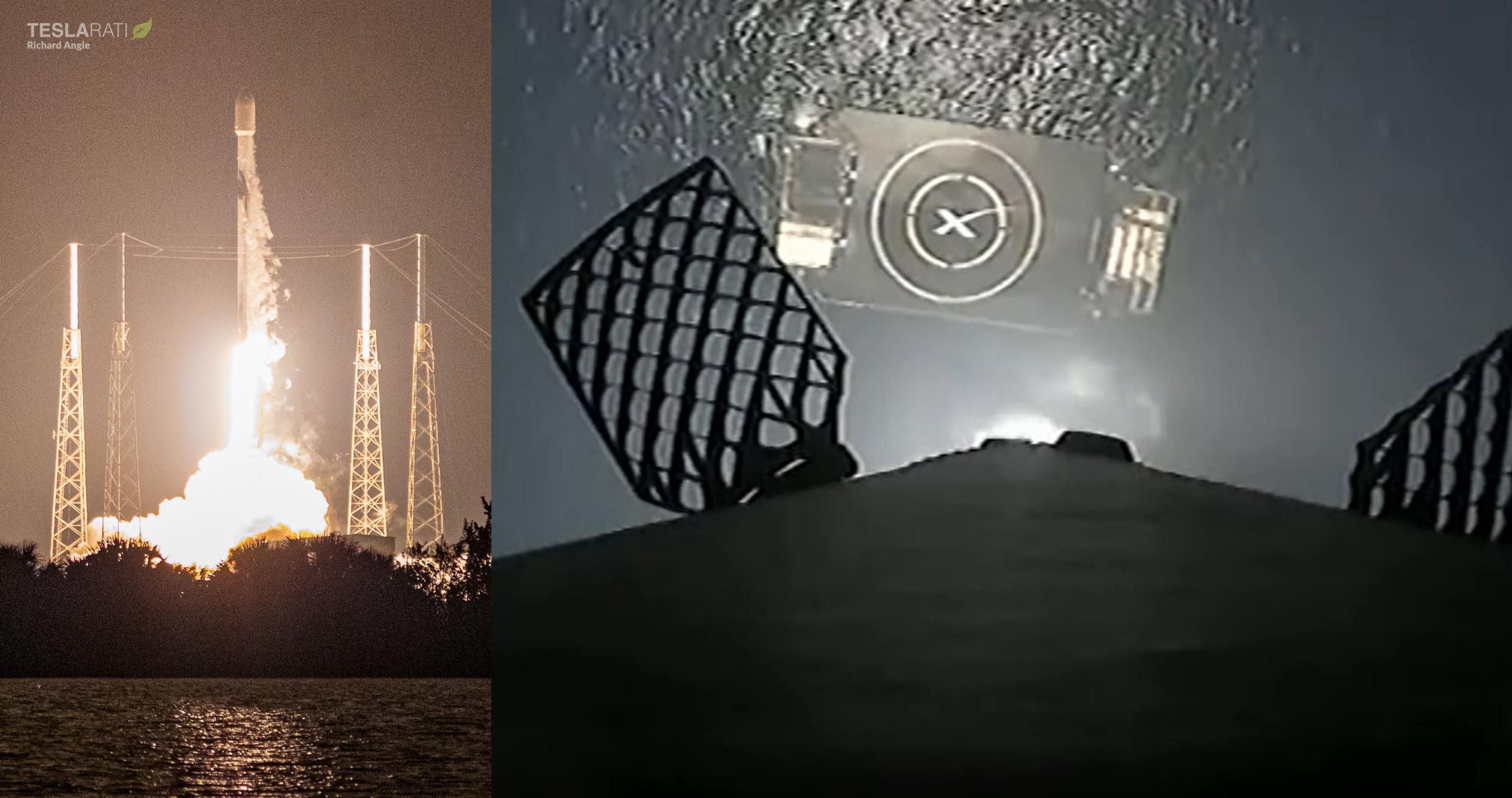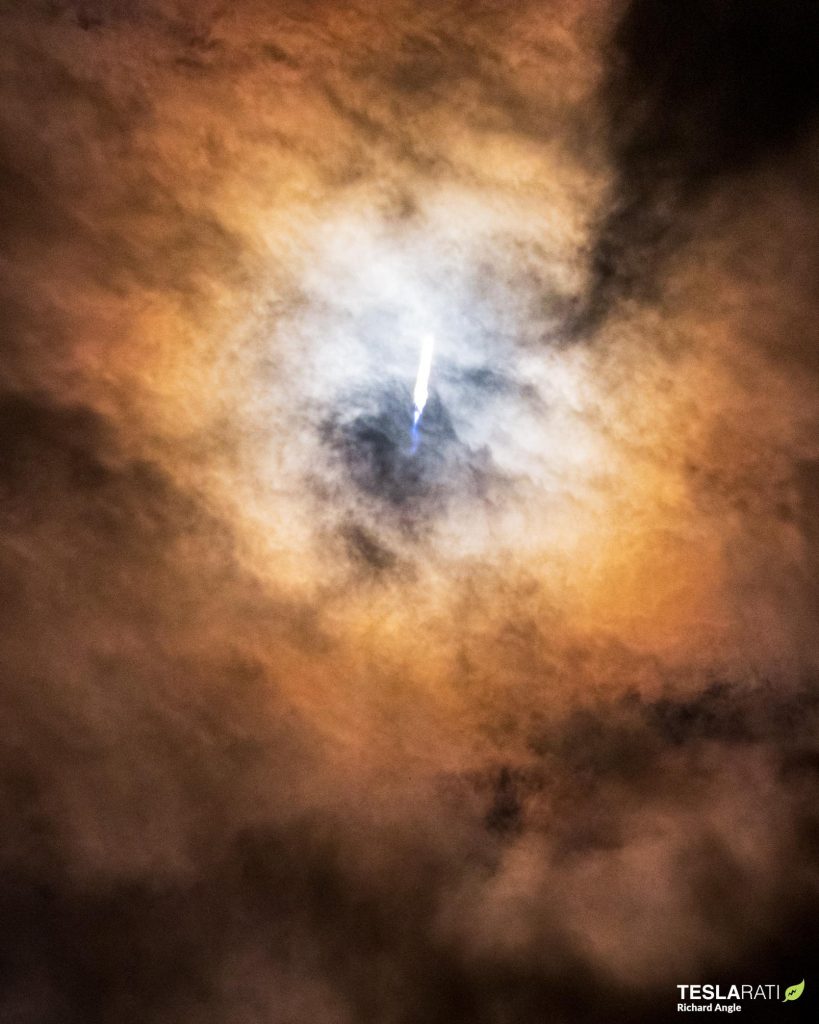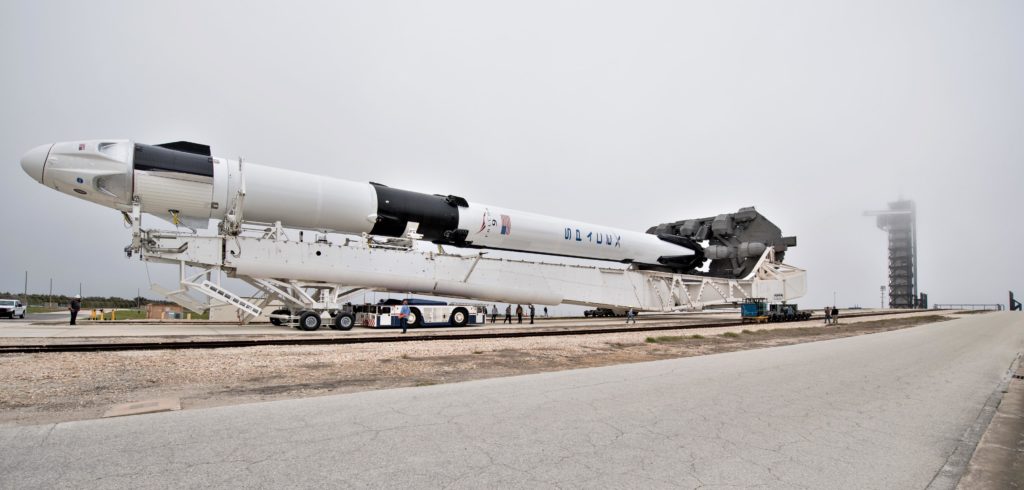

News
SpaceX Falcon 9 rocket sets reusability record, launches heaviest payload yet
SpaceX Falcon 9 booster B1051 has become the company’s ‘fleet leader’ after acing its 12th orbital-class launch and landing – a new record for the rocket family.
After a roughly 90-minute weather delay, Falcon 9 lifted off without issue around 12:48 am EST on March 19th. Booster B1051 touched down on drone ship Just Read The Instructions (JRTI) about nine minutes later, followed by the successful deployment of 53 Starlink V1.5 satellites just over an hour after launch. Starlink 4-12 was SpaceX’s 11th successful launch in the first 11 weeks of 2022. SpaceX CEO Elon Musk says that Starlink 4-12 was also the heaviest payload ever launched by Falcon 9, weighing in at 16.25 metric tons or ~35,800 pounds.

It’s not entirely clear how SpaceX was able to expand Falcon 9’s performance envelope or how far the envelope was pushed. In May 2019, Musk actually claimed that the Starlink V0.9 payload would weigh “18.5 tons” and be SpaceX’s heaviest payload ever, whereas three years later he says Starlink 4-12 set a new record of 16.25 metric tons. Assuming Musk was referring to short tons in 2019 and that SpaceX’s Starlink payload adapter and the tensioning rods that hold the stack together are roughly the same weight (~3 mT) three years later, the true total mass of Starlink 4-12’s payload could be as high as 19-19.5 metric tons (~42,000 lb). Its 53 Starlink V1.5 satellites, meanwhile, would weigh about 307 kilograms (~675 lb) each.
In other words, Starlink 4-12’s record-breaking payload could be up to 2.5 metric tons – about 15% – heavier than the Starlink V0.9 payload that set SpaceX’s internal record in 2019.


SpaceX says a Falcon 9 rocket is on track to launch Starlink 4-12 – a new batch of 53 satellites – no earlier than (NET) 11:24 pm EST on Friday, March 18th (03:24 UTC 19 March).
While ‘just’ the latest in an increasingly routine line of Starlink launches, SpaceX has confirmed that the mission will also set a new record for Falcon 9 reusability. Setting minor records is practically just as common for the average SpaceX launch but this particular record is more significant: if all goes according to plan, booster B1051 will become the first Falcon 9 first stage to complete 12 orbital-class launches and landings, pushing the envelope that much further.
The second oldest Falcon 9 booster that’s still operational, B1051 debuted in a significant way on March 2nd, 2019 by supporting Demo-1, Crew Dragon’s first uncrewed test flight. The launch was a perfect success and simultaneously kicked off the prolific careers of Crew Dragon and Falcon 9 B1051, both of which continue to have an excellent track record. Since Demo-1, B1051 has also supported the launches of Canada’s RADARSAT constellation, SiriusXM’s SXM-7 radio satellite, and 469 Starlink spacecraft spread over eight separate missions.
Starlink 4-12 will be its 12th launch and is set to occur just over two weeks after the third anniversary of its launch debut, translating to an average of one launch every three months or ~93 days. As an older booster and a fleet leader for several reusability milestones, B1051’s average turnaround time between launches – ~100 days – isn’t exceptionally impressive, though the booster has still accomplished a great deal.


However, newer boosters like B1058 and B1060 – both of which have much faster average turnaround times – are tied with B1051 at eleven flights each. One of the two is almost guaranteed to supersede B1051 in the very near future and become SpaceX’s new fleet leader, meaning that either B1058 or B1060 is likely to be the first to set new reusability records after B1051’s 12th flight.
Falcon 9 B1060, for example, has flown 11 times in 611 days, averaging one launch every 55 days and 61 days per reuse. B1060’s last two turnarounds have been under 50 days. B1058 is very similar. In other words, both B1058 and B1060 could feasibly overtake B1051 as early as May or June 2022 and could both potentially complete their 15th, 16th, or even 17th launches before the end of the year.
As such, this could be Falcon 9 B1051’s last opportunity to lead SpaceX’s fleet of Falcon boosters. Tune into SpaceX’s official webcast to watch Starlink 4-11 live around 11:10 pm EST (03:10 UTC).

News
Tesla (TSLA) receives “Buy” rating and $551 PT from Canaccord Genuity
He also maintained a “Buy” rating for TSLA stock over the company’s improving long-term outlook, which is driven by autonomy and robotics.

Canaccord Genuity analyst George Gianarikas raised his Tesla (NASDAQ:TSLA) price target from $482 to $551. He also maintained a “Buy” rating for TSLA stock over the company’s improving long-term outlook, which is driven by autonomy and robotics.
The analyst’s updated note
Gianarikas lowered his 4Q25 delivery estimates but pointed to several positive factors in the Tesla story. He noted that EV adoption in emerging markets is gaining pace, and progress in FSD and the Robotaxi rollout in 2026 represent major upside drivers. Further progress in the Optimus program next year could also add more momentum for the electric vehicle maker.
“Overall, yes, 4Q25 delivery expectations are being revised lower. However, the reset in the US EV market is laying the groundwork for a more durable and attractive long-term demand environment.
“At the same time, EV penetration in emerging markets is accelerating, reinforcing Tesla’s potential multi‑year growth runway beyond the US. Global progress in FSD and the anticipated rollout of a larger robotaxi fleet in 2026 are increasingly important components of the Tesla equity story and could provide sentiment tailwinds,” the analyst wrote.
Tesla’s busy 2026
The upcoming year would be a busy one for Tesla, considering the company’s plans and targets. The autonomous two-seat Cybercab has been confirmed to start production sometime in Q2 2026, as per Elon Musk during the 2025 Annual Shareholder Meeting.
Apart from this, Tesla is also expected to unveil the next-generation Roadster on April 1, 2026. Tesla is also expected to start high-volume production of the Tesla Semi in Nevada next year.
Apart from vehicle launches, Tesla has expressed its intentions to significantly ramp the rollout of FSD to several regions worldwide, such as Europe. Plans are also underway to launch more Robotaxi networks in several more key areas across the United States.
News
Waymo sues Santa Monica over order to halt overnight charging sessions
In its complaint, Waymo argued that its self-driving cars’ operations do not constitute a public nuisance, and compliance with the city’s order would cause the company irreparable harm.

Waymo has filed a lawsuit against the City of Santa Monica in Los Angeles County Superior Court, seeking to block an order that requires the company to cease overnight charging at two facilities.
In its complaint, Waymo argued that its self-driving cars’ operations do not constitute a public nuisance, and compliance with the city’s order would cause the company irreparable harm.
Nuisance claims
As noted in a report from the Los Angeles Times, Waymo’s two charging sites at Euclid Street and Broadway have operated for about a year, supporting the company’s growing fleet with round-the-clock activity. Unfortunately, this has also resulted in residents in the area reportedly being unable to sleep due to incessant beeping from self-driving taxis that are moving in and out of the charging stations around the clock.
Frustrated residents have protested against the Waymos by blocking the vehicles’ paths, placing cones, and “stacking” cars to create backups. This has also resulted in multiple calls to the police.
Last month, the city issued an order to Waymo and its charging partner, Voltera, to cease overnight operations at the charging locations, stating that the self-driving vehicles’ activities at night were a public nuisance. A December 15 meeting yielded no agreement on mitigations like software rerouting. Waymo proposed changes, but the city reportedly insisted that nothing would satisfy the irate residents.
“We are disappointed that the City has chosen an adversarial path over a collaborative one. The City’s position has been to insist that no actions taken or proposed by Waymo would satisfy the complaining neighbors and therefore must be deemed insufficient,” a Waymo spokesperson stated.
Waymo pushes back
In its legal complaint, Waymo stated that its “activities at the Broadway Facilities do not constitute a public nuisance.” The company also noted that it “faces imminent and irreparable harm to its operations, employees, and customers” from the city’s order. The suit also stated that the city was fully aware that the Voltera charging sites would be operating around the clock to support Waymo’s self-driving taxis.
The company highlighted over one million trips in Santa Monica since launch, with more than 50,000 rides starting or ending there in November alone. Waymo also criticized the city for adopting a contentious strategy against businesses.
“The City of Santa Monica’s recent actions are inconsistent with its stated goal of attracting investment. At a time when the City faces a serious fiscal crisis, officials are choosing to obstruct properly permitted investment rather than fostering a ‘ready for business’ environment,” Waymo stated.
News
Tesla FSD v14.2.2 is getting rave reviews from drivers
So far, early testers have reported buttery-smooth drives with confident performance, even at night or on twisty roads.

Tesla Full Self-Driving (Supervised) v14.2.2 is receiving positive reviews from owners, with several drivers praising the build’s lack of hesitation during lane changes and its smoother decision-making, among others.
The update, which started rolling out on Monday, also adds features like dynamic arrival pin adjustment. So far, early testers have reported buttery-smooth drives with confident performance, even at night or on twisty roads.
Owners highlight major improvements
Longtime Tesla owner and FSD user @BLKMDL3 shared a detailed 10-hour impression of FSD v14.2.2, noting that the system exhibited “zero lane change hesitation” and “extremely refined” lane choices. He praised Mad Max mode’s performance, stellar parking in locations including ticket dispensers, and impressive canyon runs even in dark conditions.
Fellow FSD user Dan Burkland reported an hour of FSD v14.2.2’s nighttime driving with “zero hesitations” and “buttery smooth” confidence reminiscent of Robotaxi rides in areas such as Austin, Texas. Veteran FSD user Whole Mars Catalog also demonstrated voice navigation via Grok, while Tesla owner Devin Olsen completed a nearly two-hour drive with FSD v14.2.2 in heavy traffic and rain with strong performance.
Closer to unsupervised
FSD has been receiving rave reviews, even from Tesla’s competitors. Xpeng CEO He Xiaopeng, for one, offered fresh praise for FSD v14.2 after visiting Silicon Valley. Following extended test drives of Tesla vehicles running the latest FSD software, He stated that the system has made major strides, reinforcing his view that Tesla’s approach to autonomy is indeed the proper path towards autonomy.
According to He, Tesla’s FSD has evolved from a smooth Level 2 advanced driver assistance system into what he described as a “near-Level 4” experience in terms of capabilities. While acknowledging that areas of improvement are still present, the Xpeng CEO stated that FSD’s current iteration significantly surpasses last year’s capabilities. He also reiterated his belief that Tesla’s strategy of using the same autonomous software and hardware architecture across private vehicles and robotaxis is the right long-term approach, as it would allow users to bypass intermediate autonomy stages and move closer to Level 4 functionality.








